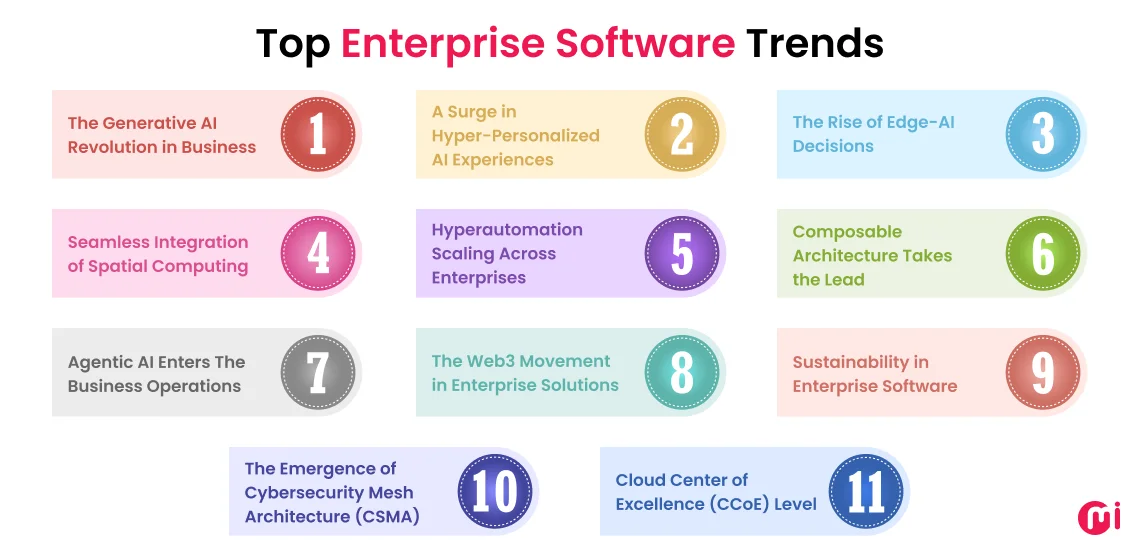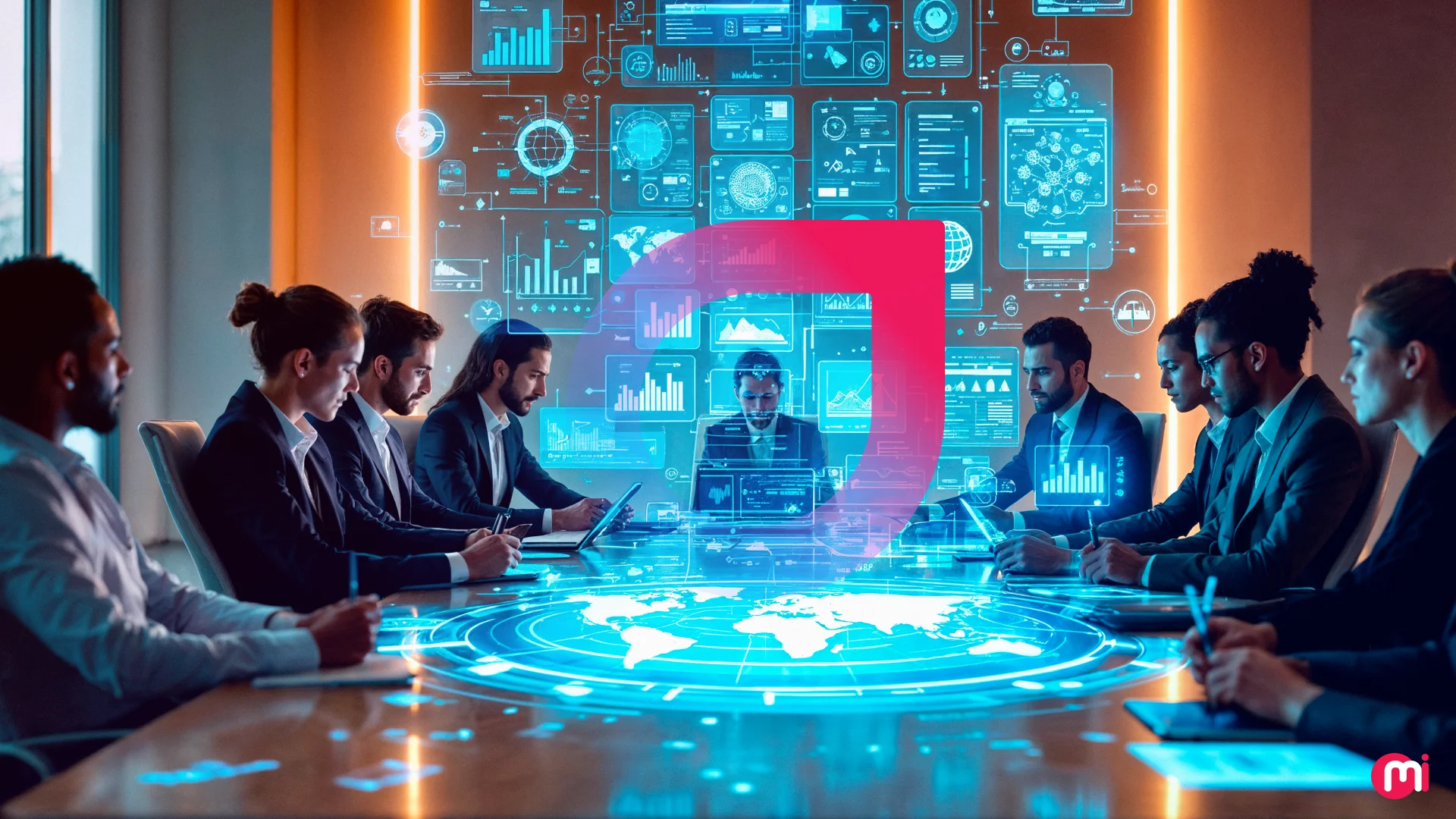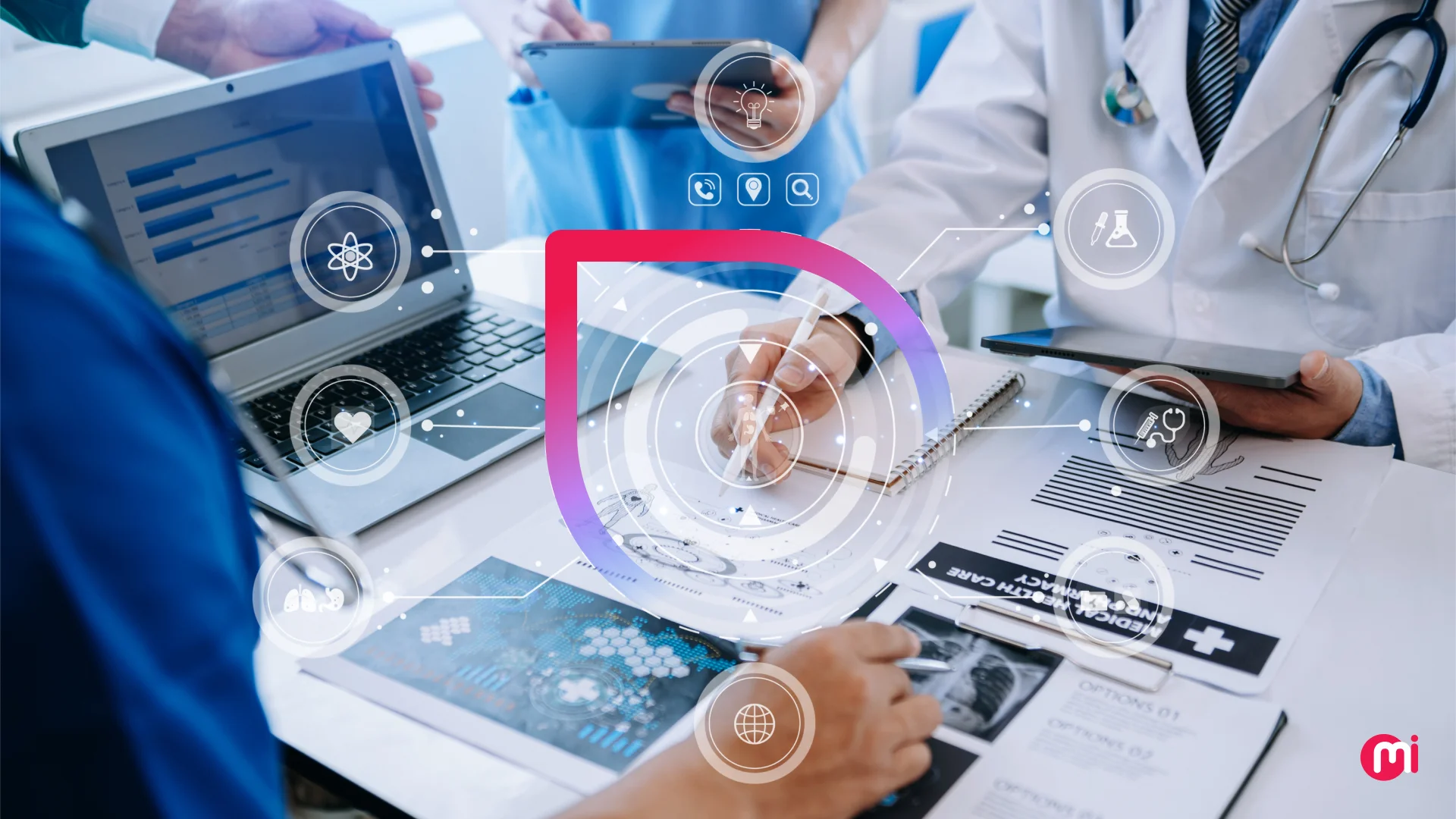Enterprise Software Trends: How They Are Reshaping Businesses
- Software
- January 10, 2025
Each year brings the excitement of discovering which trends will take center stage. For your enterprise-level business, do you still believe it’s future-proof? The enterprise software trends discussed in this blog will challenge your perspective and make the future feel like it’s already here.
The global IT spending on enterprise software development reached an impressive $1029.42 billion in 2024 and it’s expected to climb even higher in the years ahead. Core reasons behind this rising enterprise software trends include alignment with tech trends, better operational efficiency, customer engagement, and competitive advantages.
But here’s the catch: adopting the right enterprise software trend isn’t just about keeping up with the latest buzzwords. It’s about aligning your business values with technology that delivers real impact. That means:
- Staying ahead of the competition
- Future-proofing your operations
- Meeting rapidly evolving customer expectations
- Supporting sustainable growth
- Aligning with strategic objectives
- Building resilience in an uncertain, tech-driven world
To help you navigate these opportunities, we’ve compiled this blog covering top enterprise software trends for 2025. These enterprise software trends are more than just industry hype; they can be your blueprint for success not only for 2025 but beyond that.

Top 10+ Enterprise Software Trends for 2025
We’ve reviewed numerous enterprise software development trends, enterprise tech trends, and more. After analyzing over 100 research papers and sources, we’ve identified the top 10 enterprise software trends that can make 2025 the year of technological transformation and serve as a foundation for success in the years ahead.

1. The Generative AI Revolution in Business
Generative AI or Generative Artificial Intelligence has taken the digital world by storm, starting with ChatGPT and expanding into various applications. While the term “Generative AI” has been here since the mid 20th century, its true impact became evident in this last decade, revolutionizing how businesses operate with each passing year.
Generative AI, as one of the finest enterprise technology trends, it can create, convert, and read different forms of content, including text, images, and speech. It holds immense potential to save enterprises time, effort, and money with simple prompts.
Examples of Generative AI in businesses in action:
- Drug discovery
- Synthetic data generation
- Human-like conversational agents
- Content creation
- Virtual concierge services
- Image generation
- Deepfake and video synthesis
- Code generation
- Chatbots and virtual assistants
- Text-to-Speech and Voice Synthesis
- Text-to-Image and Visual Storytelling
- Language translation and content localization
- Scientific research and simulation
- AI-generated fashion
Real-World Example of Generative AI:
Open AI and Stripe have collaborated to automate financial operations, allowing users to make payments 40% faster than others. Moreover, 75% of leading generative Artificial Intelligence companies are taking the help of Stripe to go to market quickly with innovative ideas.
Many major companies, including BBVA, Unilever, and Amazon, are leveraging generative AI or Artificial Intelligence to innovate and improve customer experiences.
The future of generative AI development in enterprises is poised for transformation, focusing on enhanced human-AI collaboration, personalized experiences, task automation, multimodal AI applications, and ethical frameworks.

2. A Surge in Hyper-Personalized AI Experiences
Everyone loves recommendations that match their tastes—whether it’s for shopping, music, movies, or news. While personalization has been around for a while, hyper-personalization combined with the power of Artificial Intelligence takes it a step further by delivering highly individualized, data-driven experiences in real-time. Hence, it becomes one of the next enterprise software tech trends with potential to improve customer experience and business sales.
Hyperpersonalization uses a wide range of customer data—such as behavioral, transactional, geolocation, and contextual information—to create deeply customized interactions and offers. This goes beyond basic personalization, resulting in more relevant and engaging experiences.
Applications of Hyper-Personalization in action:
- Personalized email marketing
- Tailored product recommendations on eCommerce sites
- Dynamic website content based on past behavior
- AI-powered chatbots offering real-time support tailored to individual preferences
By leveraging hyperpersonalization, businesses can boost customer satisfaction, loyalty, and conversion rates, ultimately driving higher revenue and strengthening brand engagement.
Real-World Examples of Hyper-Personalization:
- Starbucks: By using customers’ drink preferences and habits, Starbucks personalized its app experiences and integrated real-time data with their “Star Challenge” to offer customized perks. This helped generate 31% of U.S. sales from the app.
- Spotify: Through its end-of-year Wrapped campaign, Spotify used data to create personalized stories, driving a 21% increase in app downloads and boosting sales.
Do check out more about the Starbucks journey to hyper-personalization through our blog on: how top brands leverage mobile apps to increase sales.
As AI technology evolves, the potential for hyper-personalized experiences becomes immense, enabling businesses to deliver even more tailored and impactful interactions, creating stronger customer relationships and a competitive edge.
Deloitte predicts that hyper-personalization can increase sales by 10% or more and deliver an 8x return on investment on marketing spend.
We can be your ally for enabling hyper-personalization in your enterprise software solution by allowing you to hire AI developers and data scientists from our team.
3. The Rise of Edge-AI Decisions
From many enterprise software trends, we have edge AI decision-making to be the next one driving the enterprise software development to the next level.
Edge AI is a next-gen technology that integrates AI models and algorithms with local edge devices, such as IoT sensors and smart cameras, to process data in real-time without relying heavily on cloud infrastructure. This enables faster decision-making and greater efficiency.
Applications of Edge AI in Action:
- Detecting defects and predicting maintenance needs in real-time
- Making split-second decisions for autonomous vehicles
- Fraud detection in financial systems with biometric authentication
- Inventory management and customer behavior analysis using smart cameras
- Monitoring equipment in remote locations
- Analyzing health data in wearables for real-time insights
- Optimizing energy distribution in smart grids
- Leveraging computer vision for real-world entity recognition and augmented reality
By adopting Edge AI, enterprises can enhance safety, efficiency, and compliance with data protection regulations, while lowering operational costs and driving innovation with unique solutions.
Real-World Example:
DHL, a global logistics leader, uses AI-driven computer vision in its operations for object detection, image classification, and content-based image retrieval. The company is also developing AI-powered solutions and piloting projects to stay ahead in the logistics sector.
The potential of Edge AI extends to ubiquitous deployments, enabling systems to self-optimize based on real-time data, reducing human intervention to strategic oversight. From real-time personalized retail services to dynamic pricing in transportation, Edge AI is paving the way for innovative business models and smarter, more responsive systems.

4. Seamless Integration of Spatial Computing
Spatial computing leverages AR, VR, and MR technologies to merge digital and physical spaces, enabling innovative interactions, visualization, and collaboration in three-dimensional contexts. Its adoption is gaining momentum across industries like manufacturing, healthcare, education, and retail.
Applications of Spatial Computing in Enterprise Software:
- AR solutions for assembly and maintenance
- Factory layout planning with 3D visualization
- Surgical planning and immersive medical training
- Virtual spaces for physical rehabilitation
- AR-powered virtual showrooms and tours
- Simulated office environments for remote work
Although AR/VR technologies are familiar, spatial computing as a comprehensive business application is still evolving, requiring significant investment in hardware and software. Despite this, it is rapidly becoming a powerful tool for design, training, remote work, and customer engagement through immersive experiences.
Real-World Examples:
- VSI HoloMedicine®: Mixed reality enables doctors to view patient data within the actual surgical environment.
- IKEA Place App: AR technology offers customers a virtual preview of products, helping them visualize items in their homes.
If we check the long-term vision for this trend, then:
Spatial computing could usher in a new era where computing is not just about interacting with screens but with the space around us, leading to a paradigm shift in software development.
It might foster greater collaboration between fields like psychology, design, and computer science. Through this, it can lead to the development of interfaces that are not only functional but also psychologically and ergonomically sound.
This also asks for knowing more about how to embrace the AR trend in e-commerce platforms.
5. Hyperautomation Scaling Across Enterprises
Hyperautomation enables large-scale businesses to automate complex and repetitive manual operations, improving efficiency and accuracy. Often linked to the Industry 4.0 revolution, it integrates advanced technologies to streamline processes.
Core Technologies in Hyperautomation:
- AI/ML: For intelligent data processing and decision-making
- RPA (Robotics Process Automation): To automate repetitive tasks
- BPM (Business Process Management): For modeling, monitoring, and optimizing workflows
According to Gartner, organizations combining hyperautomation with redesigned operations can reduce costs by up to 30%.
Applications of Hyperautomation in Enterprise Software:
- AI-driven process mining tools
- RPA bots for task automation
- Intelligent document processing
- Predictive analytics for data-driven decisions
- Anomaly detection systems
- Integrated Platforms as a Service (iPaaS) for seamless software interaction
Benefits of Hyperautomation:
- Frees employees for more creative and strategic work
- Supports workforce upskilling
- Enables seamless communication between enterprise systems
- Increases digital agility and enhances ROI tracking
Real-World Example of Hyperautomation:
JPMorgan’s COIN (Contract Intelligence): An AI-powered system that automates the review of commercial loan agreements, reducing the workload from 360,000 hours annually to a fraction of that time.
The Future of Hyperautomation:
Hyperautomation could transform enterprises into fully automated, intelligent environments where technology not only executes tasks but anticipates needs, optimizes operations, and drives continuous innovation.
Looking to implement hyperautomation for your enterprise operations? Our robotics process automation services can help.
6. Composable Architecture Takes the Lead
Composable software architecture is made of multiple reusable components, each implemented for specific tasks, resulting in a powerful software ecosystem. This architecture gives enterprises flexibility to assemble components in a loosely coupled manner.
Adopting this architecture can become effortless and beneficial for enterprises that have leveraged cloud services and reusable components for their operations.
Application of Composable Architecture Utilisation in Enterprise Software:
- E-commerce platform
- ERP and Business Process Automation
- Cloud-Native Applications
- Custom Enterprise Solutions
The benefits of composable architecture include:
- Faster time to market
- Improved agility in responding to market changes
- Reduced risk in system upgrades or replacements
- The ability to leverage new technologies or services as they become available.
Real-life Example of Composable Architecture Adoption in Enterprise Software:
Samsung utilized Yext’s composable enterprise solution to manage its help site experience. Post-adoption, it saw considerable improvement in CX metrics, including:
- 45% increase in Net Promoter Score (NPS)
- 33% increase in Customer Satisfaction (CSAT)
- 15% increase in issues resolved
- 19% increase in customer engagement with the help site
Gartner in one report, shares that over 70% of medium and large-sized enterprises are planning to adopt composable digital experience platform technology in application planning by 2026.
Future Possibilities for Composable Architecture:
- Can seamlessly integrate AI and automation tools
- Can play a crucial role in implementing personalization and better customer experiences
- Can become a key player in the IoT and Edge computing implementations
- Can lead to more sustainability and green IT initiatives
Also read about other software architecture patterns that can benefit your project.
7. Agentic AI Enters The Business Operations
Agentic AI is a program that operates with a degree of autonomy, initiative, and goal-oriented behavior similar to human agents. This can operate independently and make decisions as programmed without needing constant human intervention. It works up on perception, reasoning, action, and learning. RAG models are used to achieve the accelerated performance of this AI system.
Applications of Agentic AI:
- Customer services platforms, also known as digital humans – AI-powered agents
- High quality content creation and personalization
- Software engineering (can automate work hours up to 30% by 2030)
- Healthcare decision-making applications
Benefits of Agentic AI in Enterprise Operations:
- Increased efficiency and productivity
- Enhanced decision-making
- Cost reduction
- Improved customer experience
- Innovation and creativity
- Scalability
- Risk management
- Workforce augmentation
Real-world Agentic AI Implementations and Impact:
- IBM Watson Health for Oncology uses agentic AI to analyze patient data for cancer treatment, providing personalized treatment recommendations based on medical histories and diagnostic tests.
- Volkswagen uses Agentic AI for better manufacturing quality control and defect detection. Because of its implementations, it has reported 40% reduction in manufacturing defects, improving product quality and reducing waste.
Future Directions About Agentic AI Implementations:
You can expect the Agentic AI to support more sophisticated interactions and swarm intelligence and ensure human-AI collaborations.
AI investments aren’t optional – they’re essential. Discover how integrating AI in enterprise operations can transform business dynamics.

8. The Web3 Movement in Enterprise Solutions
Web3, a decentralized system powered by blockchain, offers enterprises enhanced security, complete data authority, and censorship resistance. This groundbreaking trend is steadily gaining traction in enterprise software development.
Key Applications of Web3 in Enterprises:
- Smart Contracts: Automating agreements with transparency
- Tokenization: Converting assets into digital tokens
- Decentralized Applications (dApps): Enabling secure, user-driven platforms
- Decentralized Finance (DeFi): Redefining financial systems
- Identity Management: Ensuring data privacy and sovereignty
Benefits of Web3 in Enterprise Software Development:
- Transparency and trust-building
- Automation of contracts and processes
- Data sovereignty and enhanced privacy
- Seamless interoperability across systems
- Competitive advantage through innovation
Real-World Examples:
- J.P. Morgan’s Onyx Platform: Enabled the first blockchain-based tokenized value transfer in space, facilitating secure transactions between satellites.
- Singapore Airlines’ KrisPay: A blockchain-powered loyalty program allowing customers to convert miles into digital currency. KrisPay stands as the world’s first digital wallet for frequent flyers.
The Future of Web3 in Enterprises:
Web3 is set to revolutionize enterprise operations, driving globalization with enhanced efficiency, innovative business models, heightened security, and strengthened customer trust.
This trend also raises several challenges, and to tackle such, availing expert-led Web3 development services can help.
Do checkout information on the utilization of Web3 through our infographic post on Web 3.0 – Everything You Need to Know.
9. Sustainability in Enterprise Software
Amongst all enterprise software market trends, this one for sustainable solutions stands as the most impactful and necessary one to adopt, considering current environmental impact.
We at MindInventory have previously worked with brands with a mission to save the planet with eco-friendly offerings. We helped Caulibox – London’s first reusable lunchbox scheme, in its green initiatives to sell eco-friendly lunchboxes with mobile app development, creating impacts like a decrease of 2.35 MJ of energy consumption per use, 237.5 g of CO2 emission reduction, and saving 9.75 L of water consumption per use.
What is this sustainable IT initiative?
Sustainability in software development refers to designing and deploying software solutions that minimize environmental impact while delivering long-term business value. This involves optimizing code for energy efficiency, efficient data management, and sustainable cloud practices.
Key Applications of Sustainability in Enterprises Software Development:
- Environmental Management Systems
- Sustainable Supply Chain Management
- Sustainability Reporting and Compliance
- Resource and Waste Management
- Sustainable Agriculture and Manufacturing
- Corporate Social Responsibility (CSR) Platforms
Benefits of Sustainability:
- Reduced operational costs and carbon footprint
- Enhanced efficiency and market differentiation
- Easier compliance with environmental regulations
- Long-term business viability and innovation opportunities
Real-World Implementations for Enterprise Sustainability Initiatives and Impact:
- SAP Sustainability Manager: Enables companies to measure emissions and manage sustainability goals while ensuring energy-efficient cloud operations.
- Salesforce Net Zero Cloud: Assists businesses in tracking and managing carbon emissions to achieve net-zero targets.
Tech giants like Microsoft and Google are also investing heavily in sustainability, reinforcing its importance in shaping future enterprise strategies.
The Growing Relevance of Sustainability:
Sustainability is more than just a trend; it’s a long-term commitment that will gain momentum as businesses increasingly prioritize eco-friendly practices. Enterprises adopting sustainable software solutions are not only contributing to a healthier planet but also gaining a competitive edge.
10. The Emergence of Cybersecurity Mesh Architecture (CSMA)
You can say this enterprise software trend is built to secure modern, distributed enterprise IT infrastructures, which offers a collaborative ecosystem of tools and controls. It is an emerging security framework designed to address the complexities of modern IT environments, particularly those involving distributed systems, cloud computing, and remote workforces.
It moves away from traditional perimeter-based security models towards a more decentralized, flexible, and scalable approach.
Applications in Enterprise Software Development:
- Integration of Security Tools
- Decentralized Security Control
- Identity-Centric Security
Benefits of CSMA for Enterprises:
- Improved security posture
- Cost efficiency
- Operational agility
Real-World Implementation of CSMA and Impact Metrics:
Fortinet Security Fabric – it is designed with CSMA to integrate various security products into a unified security framework for hybrid environments.
One Gartner report reveals that almost 73% of organizations that have built CSMA feel satisfied with their organization’s progress.
Plus, over 71% of leaders believe that CSMA will become a standard component of security operations.
11. Taking Enterprise Operations to the Cloud Center of Excellence (CCoE) Level
A Cloud Center of Excellence (CCoE) is a strategic enterprise initiative focused on enhancing cloud adoption and management practices to achieve operational excellence, drive innovation, and boost efficiency. It often involves establishing a dedicated cloud computing team responsible for leading, governing, and optimizing cloud services across the organization.
Core Components of a CCoE:
- Governance: Establishes cloud architecture guidelines, ensures regulatory compliance, and manages cloud costs.
- Brokerage: Helps select the right cloud vendors and services for specific business units.
- Community: Builds a culture of cloud knowledge sharing and collaboration.
Applications of a CCoE in Enterprises:
- Developing and executing cloud migration strategies
- Optimizing cloud costs for better ROI
- Standardizing cloud architecture and practices
- Implementing disaster recovery and business continuity plans
- Ensuring sustainable cloud operations
- Managing multi-cloud strategies effectively
- Driving cloud-native application development
Real-World Example:
Spotify adopted a CCoE framework to foster a culture of rapid innovation through cloud-native principles. This approach enabled them to accelerate time-to-market for new features, manage millions of users with minimal latency, and achieve seamless cloud operations.
Future Outlook of CCoEs:
CCoEs represent the future of strategic cloud computing, offering enterprises a more agile, secure, and sustainable approach. By implementing a CCoE, organizations can gain a competitive edge, improve operational efficiency, and establish leadership in innovation.
To achieve all, it also asks for availing expert-led cloud engineering services.
Key Considerations When Adopting Modern Enterprise Software Trends
Adopting the latest enterprise software market trends is exciting, but ensuring these trends align with ethical, secure, and operational needs is critical. Here are three key considerations to guide this transformation:
1. Ethical AI
With AI becoming a more integral part of enterprise software systems, it becomes important to keep ethical considerations at the forefront.
Why It Matters:
- AI is prone to making biased decisions due to the quality of data it has been fuelled to, leading to unfair outcomes.
- Misuse of AI in decision-making can result in reputational damage and legal risks.
What to Focus On:
- Implement clear and unbiased algorithms
- Establish governance frameworks
- Adopt AI solutions that match business values and societal norms
2. Data Privacy and Security
In this digital age of interconnected systems, where data is an asset for business opportunities and better customer experience, safeguarding such sensitive information (about customers).
Why It Matters:
Cyberattacks, data breaches, and privacy violations can erode customer trust and incur financial penalties under stringent regulations like GDPR or CCPA.
What to Focus On:
- Adherence to regional and global privacy regulations
- Implementation of robust data encryption and cybersecurity
- Use of AI-drive threat detection for continuous proactive monitoring and risk mitigation
3. The Skill Gap
Adopting new trends like hyperautomation, edge AI, or Web3 requires skilled talent to implement and maintain these innovations effectively.
Why It Matters:
Lack of specialized skills can lead to implementation delays, underutilization of tools, and lower ROI.
Ensuring enterprise application modernization and migration can be a struggle.
What to Focus On:
- Investing in upskilling investments
- Collaboration with expert tech partners
- Prioritizing hiring skilled professionals (can opt for dedicated team augmentation offerings)
By addressing these considerations, enterprises can successfully integrate cutting-edge software trends while minimizing risks and maximizing benefits.
Stay Ahead with MindInventory: Your Partner in Enterprise Software Evolution
When it comes to working on unique concepts and industry innovation, MindInventory has always been a premier choice for enterprise software solutions. From strategic consultation to enterprise mobility solutions to custom enterprise software development to enterprise digital transformation, our offerings cater to businesses with all sorts of unique requirements.
Whether empowering I.AM+ – a Hollywood celebrity-led (Will.I.AM) super app with advanced AI assistance, or assisting in a unique software concept called BipedAI, an AI and computer vision-powered co-pilot for visually impaired individuals, MindInventory has been delivering cutting-edge software development solutions to enterprises since inception.
So, are you also interested in transforming your enterprise operations or offerings for customers? Our software developers can help you in your business transformation endeavors. Contact us today!













